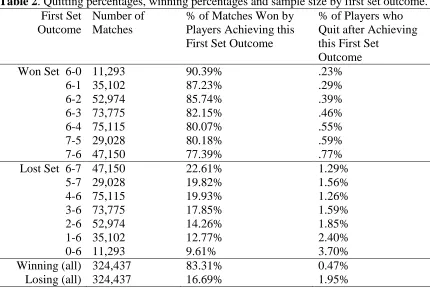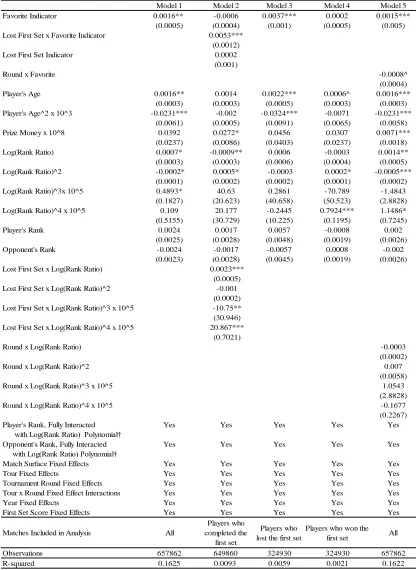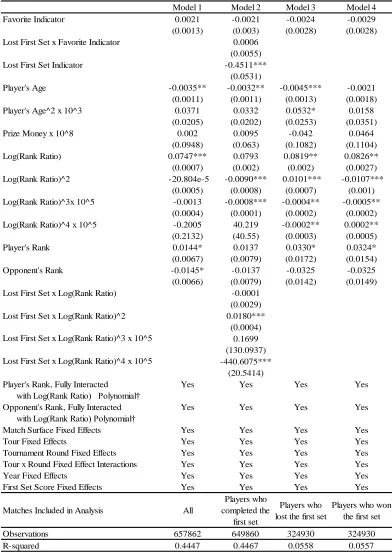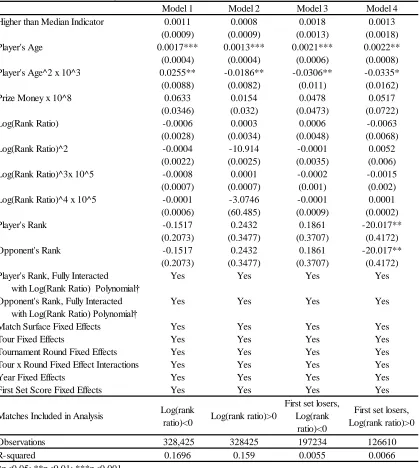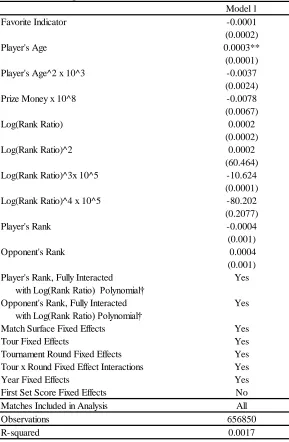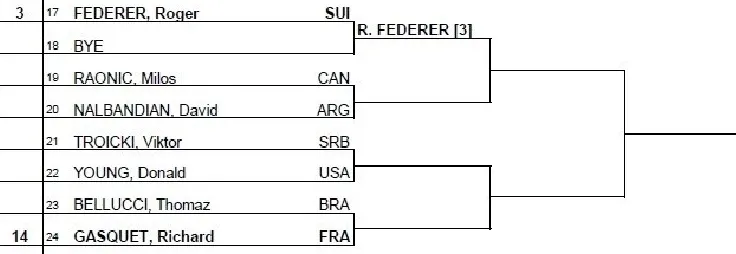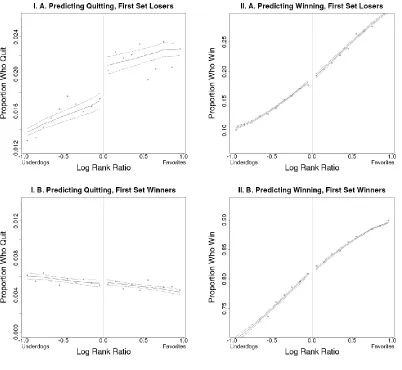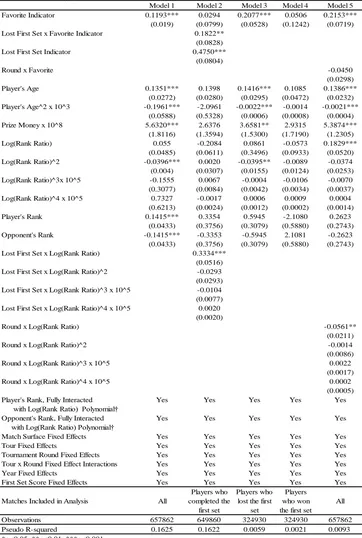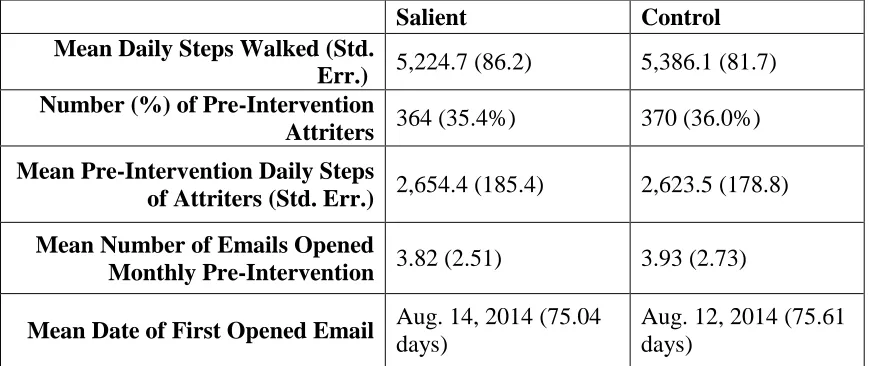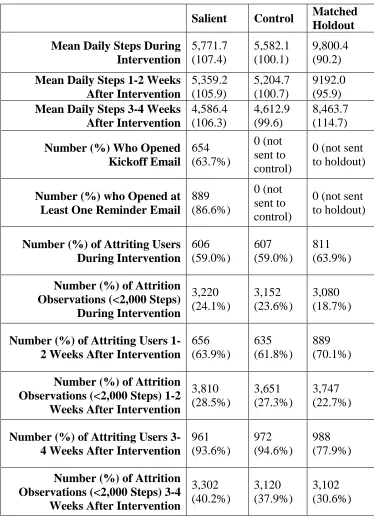University of Pennsylvania
ScholarlyCommons
Publicly Accessible Penn Dissertations
1-1-2015
Essays in Behavioral Economics
Bradford Tuckfield
University of Pennsylvania, brt@wharton.upenn.edu
Follow this and additional works at:http://repository.upenn.edu/edissertations
Part of theEconomics Commons, and theOrganizational Behavior and Theory Commons
This paper is posted at ScholarlyCommons.http://repository.upenn.edu/edissertations/2065 For more information, please contactlibraryrepository@pobox.upenn.edu.
Recommended Citation
Essays in Behavioral Economics
Abstract
This dissertation is on topics in behavioral economics. It contains two chapters that are methodologically and topically distinct.
The first chapter is entitled “Quitting: The Downside of Great Expectations in Competitions.” This research examines ranked professional athletes who compare themselves with their opponents. Athletes with better rankings than their competitors are called “favorites” and are expected to win. Athletes with worse rankings than their competitors are called “underdogs” and are expected to lose. Favorites enjoy many advantages over other competitors, but this chapter demonstrates that favorites are also more likely to quit in competition than underdogs. This is particularly true when competitors face adversity. When favorites begin to lose, they may attempt to save face by quitting, and thereby manage the impressions that others form of them. This chapter reports on an analysis of 328,425 men’s professional tennis matches and demonstrates that favorites are discontinuously more likely to quit mid-match than underdogs. It also contains results from surveys and interviews of athletes that support an impression management account for the observed quitting pattern.
The second chapter in this dissertation is entitled “The Role of Incentive Salience in Habit Formation.” This research consists of analysis of data from a behavioral intervention related to exercise. In this intervention, pedometer wearers received incentives for every step they took over the course of a two week period. Users were randomly assigned to a “salient” condition, in which incentives were announced and explained in repeated emails, and a “non-salient” condition, in which information about incentives could be easily
accessed, but was not sent to users via email. The purpose of the experiment was to compare the average daily steps in the “salient” and the “non-salient” conditions after the intervention period concluded to determine if longer-lasting post-intervention walking habits were induced when enhanced incentives were highlighted. Results indicate that the salience manipulation was successful and led to greater daily steps during the intervention, and to habits that persisted after the end of the intervention.
Together, the chapters in this dissertation contribute to the substantial and growing literature on individual decision making.
Degree Type
Dissertation
Degree Name
Doctor of Philosophy (PhD)
Graduate Group
Operations & Information Management
First Advisor
Katherine L. Milkman
Subject Categories
Economics | Organizational Behavior and Theory
ESSAYS IN BEHAVIORAL ECONOMICS
Bradford Tuckfield
A DISSERTATION
in
Operations and Information Management
For the Graduate Group in Managerial Science and Applied Economics
Presented to the Faculties of the University of Pennsylvania
in
Partial Fulfillment of the Requirements for the
Degree of Doctor of Philosophy
2015
Supervisor of Dissertation
Professor Katherine L. Milkman, James G. Campbell, Jr. Assistant Professor of OPIM
Graduate Group Chairperson
Professor Eric Bradlow, K.P. Chao Professor of Marketing
Dissertation Committee
Professor Katherine L. Milkman, James G. Campbell, Jr. Assistant Professor of OPIM
Professor Maurice E. Schweitzer, Cecilia Yen Koo Professor of OPIM
ii ABSTRACT
ESSAYS IN BEHAVIORAL ECONOMICS
Bradford Tuckfield
Professor Katherine L. Milkman
This dissertation is on topics in behavioral economics. It contains two chapters
that are methodologically and topically distinct.
The first chapter is entitled “Quitting: The Downside of Great Expectations in
Competitions.” This research examines ranked professional athletes who compare
themselves with their opponents. Athletes with better rankings than their competitors are
called “favorites” and are expected to win. Athletes with worse rankings than their
competitors are called “underdogs” and are expected to lose. Favorites enjoy many
advantages over other competitors, but this chapter demonstrates that favorites are also
more likely to quit in competition than underdogs. This is particularly true when
competitors face adversity. When favorites begin to lose, they may attempt to save face
by quitting, and thereby manage the impressions that others form of them. This chapter
reports on an analysis of 328,425 men’s professional tennis matches and demonstrates
that favorites are discontinuously more likely to quit mid-match than underdogs. It also
contains results from surveys and interviews of athletes that support an impression
iii
The second chapter in this dissertation is entitled “The Role of Incentive Salience
in Habit Formation.” This research consists of analysis of data from a behavioral
intervention related to exercise. In this intervention, pedometer wearers received
incentives for every step they took over the course of a two week period. Users were
randomly assigned to a “salient” condition, in which incentives were announced and
explained in repeated emails, and a “non-salient” condition, in which information about
incentives could be easily accessed, but was not sent to users via email. The purpose of
the experiment was to compare the average daily steps in the “salient” and the
“non-salient” conditions after the intervention period concluded to determine if longer-lasting
post-intervention walking habits were induced when enhanced incentives were
highlighted. Results indicate that the salience manipulation was successful and led to
greater daily steps during the intervention, and to habits that persisted after the end of the
intervention.
Together, the chapters in my dissertation contribute to the substantial and growing
iv
TABLE OF CONTENTS
Title……….……….…Page i
Abstract………..……….…….…..……….…Page ii
Lists of Tables and Illustrations………..Page v
Dissertation……….………..…Pages 1-98
Chapter 1: Quitting: The Downside of Great Expectations in Competitions
(working paper)…………... Pages 1-63 Contents:
o Abstract…………...Page 1
o Text…………...Pages 2-36
o References…………...Pages 37-46
o Tables and Figures…………...Pages 47-53
o Appendices…………...Pages 54-63
Chapter 2: The Role of Incentive Salience in Habit Formation……… Pages 64-98
Contents:
o Abstract…………...Page 64
o Text…………...Pages 65-80
o References…………...Pages 81-82
o Tables and Figures…………...Pages 83-87
v List of Tables
Chapter 1, Table 1: Summary statistics
Chapter 1, Table 2: First set and match outcomes Chapter 1, Table 3: Regressions predicting quitting Chapter 1, Table 4: Regressions predicting winning Chapter 1, Table 5: Placebo discontinuity tests Chapter 1, Table 6: Predicting walkovers
Chapter 1, Table A1: Regressions with logit specification
Chapter 2, Table 1: Summary statistics of pre-treatment characteristics Chapter 2, Table 2: Summary statistics of during and post-treatment behavior Chapter 2, Table 3: Regressions predicting walking
Chapter 2, Table 4: Regressions predicting walking with holdout control Chapter 2, Table S1: Regressions predicting walking
Chapter 2, Table S2: Regressions predicting walking with holdout control Chapter 2, Table S3: Regressions predicting walking, different clustering
Chapter 2, Table S4: Regressions predicting walking with holdout control, new clustering Chapter 2, Table S5: Regressions predicting walking, Winsorized
Chapter 2, Table S6: Regressions predicting walking with holdout control, Winsorized
List of Illustrations
Chapter 1, Figure 1: Example portion of tournament draw
Chapter 1, Figure 2: Quitting rates, favorite status, and match outcome Chapter 2, Figure 1: Mean daily steps before, during, and after treatment Chapter 2, Figure S1: Kickoff email
Chapter 2, Figure S2: Reminder email
1 CHAPTER 1
Quitting: The Downside of Great Expectations in Competitions
Joint work with: Berkeley Dietvorst, Prof. Katherine L. Milkman, and Prof. Maurice E. Schweitzer
Abstract for Chapter 1
2 INTRODUCTION
Within and between organizations, competition is pervasive. Individuals routinely
compete for resources and status (Kilduff et al. 2010; Pierce, Kilduff, Galinsky, and
Sivanathan, in press; Deutsch, 1949; Chan, Li, and Pierce, 2014). Not only is competition
common, but it is also often necessary and valuable. Competition can guide markets to
reach equilibria, help organizations identify their most qualified employees, and help
managers allocate resources efficiently (Stigler, 1957; Beersma et al., 2003).
Competition, however, is not just a means to an end; it has a profound impact on
those involved. Competition occurs within a social context and is “inherently relational”
(Kilduff et al., 2010, p. 961). It is such a powerful force that it consistently and
predictably shapes actors’ decisions (Pierce, Kilduff, Galinsky, and Sivanathan, 2014).
The experience of competition is influenced by competitors’ relationships, not only with
each other, but also with supporters and other observers. As a result, social constructs
such as expectations are likely to shape both competitive processes and competitive
outcomes.
Many competitions involve a favorite, an individual who is expected to win, and
an underdog, an individual who is expected to lose. There are many well-established
advantages associated with being a favorite. Compared to underdogs, favorites enjoy
greater self-efficacy, higher motivation, enhanced performance (McNatt & Judge, 2004)
and even better physical endurance (Weinberg et al., 1980). Further, the high
expectations that accompany being a favorite improve attitudes, promote positive
3
loss (Eden & Aviram, 1993). The benefits of being a favorite have been documented
across diverse domains (Eden, 2003) ranging from corporations to the military (Eden &
Zuk, 1995), academia (Chapman and McCauley, 1993), and experimental laboratories
(Gold, 1999). In sum, past research has identified a host of advantages to being a favorite.
In this paper, we examine decisions favorites and underdogs make about whether
to persist or quit in a competition. If competitors focused exclusively on winning, we
would expect favorites to be more likely to persist than underdogs. After all, favorites are
more likely to succeed than underdogs and persisting should be easier for favorites
because they are more skilled and enjoy greater self-efficacy (McNatt and Judge, 2004).
However, we theorize that competitors pursue other objectives in addition to
winning. Specifically, we conjecture that impression management motives may lead
favorites to quit more often than underdogs. Particularly when facing a likely loss, favorites may derive greater impression management benefits from quitting than
underdogs. Instead of violating expectations (and losing), favorites who quit promote a
self-serving counterfactual: they could have won. Thus under some conditions, the
impression management benefits of quitting may outweigh the benefits of persisting for
favorites.
Consider, for example, the paradigmatic incumbent politician who is behind in the
polls and quits a race citing the need to spend more time with family. By quitting, the
politician accomplishes two impression management objectives. First, she communicates
4
excuse for her poor performance. Second, the politician avoids the salient, negative, and
expectation-violating experience of losing.
Thus, we propose that due to impression management concerns, being labeled a
favorite has an unexpected drawback: it can reduce persistence. We further predict that
holding all else equal, assignment to favorite status (rather than underdog status) will be
particularly likely to cause individuals to quit in competitions when early performance
suggests that victory is unlikely.
To investigate these predictions, we identified a setting in which we could
observe competitions with several key features. Specifically, we sought a setting where
we could observe high stakes competitions and could objectively (a) classify competitors
along a continuum from extreme favorites to extreme underdogs, (b) assess each
competitor’s prospects of prevailing mid-way through a competition, and (c) observe
quitting behavior. We chose to analyze data from a rich, archival data set of 328,425
professional men’s tennis matches.
Our investigation contributes to a growing literature that has drawn important
managerial insights from archival records of athletic competitions (e.g., see Reifman,
Larrick and Fein, 1991; Kilduff et al. 2010; Larrick et al., 2011; Pope and Schweitzer,
2011). In our analyses, we find that holding all else equal, classification as a favorite
(rather than an underdog) causes competitors to quit more often, particularly when
competitors are facing a probable defeat. The athletes in our dataset are strongly
incentivized experts. They have trained for years in the performance domain that we
5
rewards. Importantly, quitting in this setting has no immediate economic advantages over
losing; for professional tennis players, quitting and losing have identical implications for
world rankings and pay (according to the official rulebook of the Association of Tennis
Professionals). That is, compared to experiencing a loss, quitting in this setting yields
identical ranking and tournament outcomes, but has potentially different impression
management consequences.
With this study, we identify an important disadvantage to being a favorite. We
contribute to an emerging literature that has qualified prior findings that have identified
substantial benefits to being a favorite. For instance, recent studies have revealed that
favorites may suffer from overconfidence (McGraw et al., 2004) and may be less well
liked than underdogs (Goldschmied & Vandello, 2009; McGinnis & Gentry, 2009;
Paharia, Keinan, Avery and Schor, 2011). Our investigation identifies a very different
drawback to being a favorite and postulates a very different mechanism through which
being a favorite can adversely affect performance and persistence. Specifically, we
highlight a novel drawback to being a favorite: the impression management concerns
created by high performance expectations reduce persistence. In sum, integrating prior
research, we demonstrate that there are not only benefits but also costs to being a
favorite.
Impression Management
We theorize that impression management concerns cause favorites to exit
competitions prematurely. Specifically, we argue that favorites face higher expectations
6
In social contexts, people are concerned with the impressions they create.
Impression management is “the process by which individuals attempt to control the
impressions that others form of them” (Leary and Kowalski, 1990, p. 34). A number of
industries illustrate the widespread demand for creating positive impressions, from the
multi-billion dollar market for cosmetics to the market for image consultants and public
relations departments. Sometimes managing impressions even involves deception:
popular websites like cantyouseeimbusy.com offer games that employees can play while
maintaining the appearance that they are working. Though we recognize that impression
management concerns can have both intrapersonal and interpersonal implications (Apsler
1975; Modigliani 1971; Stevens and Kristof, 1995), with respect to quitting behavior, we
consider holistic impression management concerns.
Impression management concerns guide many decisions within organizations. For
example, past research has demonstrated that impression management motives affect how
organizational actors express their opinions, engage in prosocial behavior, and make
apologies (Gardner and Martinko, 1988; Grant and Mayer, 2009; Jain, 2012; Chiaburu,
2014). Further, behaviors inspired by impression management motives have also been
demonstrated to influence important outcomes such as perceptions of employees’
performance (Wayne & Liden, 1995) and of interviewees (Baron, 1986).
Self-Handicapping as an Impression Management Strategy
Self-handicapping is an impression management strategy in which individuals
take action to limit their own performance and create an external attribution for poor
7
this paper, we focus on a specific type of self-handicapping: quitting. We postulate that
favorites quit to manage impressions. By self-handicapping, individuals take a
pre-emptive action that makes the link between poor performance and their true abilities
more ambiguous (Jones and Berglas, 1978). For example, a student who anticipates
performing poorly on a test may stay out late drinking the night before the test and then
blame his failure on a hangover rather than incompetence. Self-handicapping is an
attractive strategy for individuals who expect to fall short of expectations because it
provides an external attribution (e.g. alcohol poisoning) for poor performance and thus
weakens the link between poor performance and personal failings.
Past research suggests that self-handicapping is prevalent. Scholars have
documented self-handicapping in domains ranging from athletics (e.g. Ntoumanis et al.,
2010) to academics (e.g. Gadbois & Sturgeon, 2011). Self-handicapping is an impression
management strategy that is particularly relevant to quitting in competitions because it
can provide an excuse both for poor performance and for exiting a competition
prematurely. For example, an employee competing to be the top salesperson in a given
month can claim she is having family problems to create both an external reason for
failing to win the competition and an excuse for exiting the competition before it has
concluded. This same self-handicapping phenomenon is reflected in athletic
competitions. Athletes who quit by falsely claiming to be injured create an external
attribution for their poor performance (the injury), and generate an excuse for exiting the
competition before it has concluded. However, not all competitors face the high levels of
8 Role Expectations and Impression Management
Favorites and underdogs, by construction, face different performance
expectations. These different performance expectations influence differences in both
impression management concerns and impression management strategies. Past research
has shown that people strive to meet the positive expectations associated with their social
or professional roles (Leary & Kowalski, 1990). Impression management in
role-governed situations is often based on a prototype-matching process: individuals seek to
conform as closely as possible to the prototypical characteristics of whatever role they are
playing (e.g., leader, minister, police officer, professor, etc.; Leary, 1989). For example,
Jones et al. (1963) found that Reserve Officers’ Training Corps cadets with different
levels of status managed the impressions they made on others differently according to
their respective roles. In related work, Leary et al. (1986) found that leaders who believed
that a particular type of leadership style was most effective for a particular situation
attempted to foster impressions of themselves that matched the prescribed leadership
style. In line with this, Marr and Thau (2013) found that high-status individuals are more
threatened by losses. Together, this research shows that people use impression
management strategies to conform to the expectations of their role. Within competitions,
we would expect favorites and underdogs to use impression management strategies to
conform to the expectations of their respective roles.
Expectations in Competitions
Favorites and underdogs face different expectations in competitions. In our
9
competitors’ relative ranks influence performance expectations. Expectations influence
competitive behavior, and past scholarship has substantially developed our understanding
of how people develop performance expectations (e.g. Bandura, 1997; Buckley et al.,
1998). One common organizational tool that communicates performance expectations is a
ranking system.
Ranking systems pervade organizations. Firms such as G.E. and Accenture use
rankings to rate, reward, and promote employees (Olson, 2013). Similarly, sales and
productivity rankings are common in organizations (Barankay, 2014), and organizations
and products are often ranked based on their quality and performance (Luca & Smith,
2013). Rankings are also widely used in other settings: students in schools are often
ranked (Johnson, 2006) and professional athletes and teams are routinely ranked (Berry,
2003). A reliable ranking system succinctly summarizes available information about
relative skill. Further, rankings can directly inform dichotomous performance
expectations. That is, when making predictions about outcomes, we expect higher ranked
individuals and teams to outperform or defeat lower ranked individuals and teams.
Past research has shown that rankings inform our expectations about the quality of
competitors and thus influence our decisions. For example, rankings influence hospital
choice (Pope, 2009), restaurant selection (Luca, 2014), webpage visits (Ghose et al.,
2013), and which universities students attend (Dill and Soo, 2005; Luca and Smith, 2011;
Carter, 1998). In the domain of sports, bettors routinely pick “favorites” to win in
competitive matchups (Levitt, 2004), even after the bet is altered so that underdogs are
10
not only others’ expectations, but also the competitor’s own behavior. For example,
managers whose organizations are given a ranking that deviates from their beliefs are
more likely to initiate organizational change (Martins, 2005; Espeland & Sauder, 2007).
Taken together, prior research demonstrates that people pay attention to rankings and
form expectations about relative quality and competitive outcomes based upon rankings.
Expectations about success, often informed by ranking information, influence the
effort that competitors exert and how they react to defeat. For example, Nelson and Furst
(1972) found that competitors were more likely to win an arm strength contest when they
were told that they were favored to win. This research highlights that whether or not
individuals expect to win substantively changes their behavior in competitions. In related
work, Weinberg et al. (1980) demonstrated this by measuring performance in a leg lifting
task. Weinberg et al., (1980) asked participants to sit in a chair and hold their legs above
the ground for as long as they were able. Participants were timed and their times were
compared to those of their assigned opponents. Weinberg et al. (1980) found that how
participants performed—and how they reacted to defeat—was affected by whether or not
they expected to win. When participants were told that they had competed with and lost
to an athlete, they were less upset than when they were told that they had competed with
and lost to a recovering surgery patient.
Although better rankings can benefit competitors in many ways (e.g., by
enhancing self-efficacy, motivation, and performance; McNatt and Judge, 2004), we
argue that past research has largely overlooked the important possibility that better
11
impression management challenges. We theorize that better-ranked competitors
(favorites) will feel greater pressure than underdogs to avoid defeat because avoiding
defeat is required for favorites to meet performance expectations. Particularly when
favorites begin to lose, we postulate that they may prefer to self-handicap (e.g., by
claiming a false injury and quitting), rather than persist.
Quitting
Public officials, athletes, managers, employees and private citizens frequently
face decisions about whether to quit or persist. Often, people quit prematurely when
perseverance would be wise (Glebbeek & Bax, 2004; Bowen, 1982; Ewusi-Mensah &
Przasnyski, 1991; Shalvi et al., 2013; Weber & Camerer, 1998). Prior work has found
that people are more likely to quit competitions when they feel that their chance of
winning is small (Muller & Schotter, 2010), when winning requires high effort
(Fershtman & Gneezy, 2011), and when they experience anxiety (Brooks & Schweitzer,
2011). We show that, in addition to these other drivers of quitting, impression
management concerns can lead people to quit prematurely.
Within a competition, the ideal way to manage impressions is to win. Winners
project talent and competence. However, when winning is improbable, quitting may offer
another acceptable impression management strategy via self-handicapping: conveying an
excuse for poor performance. In elections, politicians often quit claiming the pressing
need to spend time with family. In physical competitions, competitors often quit after
claiming an injury. Like politicians who claim family troubles and indeed have ill family
12
competitors also sometimes quit and falsely claim that they are injured. We confirmed
this by surveying a sample of professional men’s tennis players (N=11; median age = 26;
median years on the pro tour = 8). They unanimously agreed that some professional
tennis players quit for reasons other than sickness and injury.1 By quitting, we theorize
that competitors who face a loss can manage impressions by avoiding an explicit loss,
and by instead offering an external attribution for their subpar performance.
Qualitative evidence suggests that athletes do use reports of illness and injury as a
self-handicapping strategy. Rhodewalt, Saltzman, and Wittmer (1984) found in a survey
study that competitive athletes with a high tendency to self-handicap were also more
likely to report illness and injury. Previous work, however, has not explored the
relationship between expectations and self-handicapping decisions. We show in a large,
archival field study that performance expectations influence quitting: holding all else
equal, competitors assigned the status of a favorite (as opposed to an underdog) are more
likely to quit. This finding is moderated by initial success; competitors who are endowed
with favorite status and who face a probable loss are more likely to quit than underdogs.
Hypotheses
By providing an ordered list of competitors’ quality, ranking systems create
favorites and underdogs in competitions. Favorites face different performance
expectations than underdogs: favorites are expected to win, whereas underdogs are
expected to lose. With respect to these expectations, underdogs have the potential to
either meet expectations or exceed them. In contrast, favorites have the potential to either
13
meet expectations or fall short of them. These dynamics crate different impression
management concerns for favorites and underdogs. Quitting is an impression
management strategy that allows favorites to mitigate the harmful impression
management consequences of a potential defeat. Specifically, quitting is a form of
self-handicapping, as it gives competitors an alternative, external attribution for poor
performance besides low skill (e.g., injury). We predict that due to the higher impression
management risks they face in competition, otherwise identical competitors who are
arbitrarily classified as slight favorites will employ the impression management strategy
of quitting at a higher rate than competitors arbitrarily classified as slight underdogs. In
other words, we predict that otherwise identical competitors will persist more or less
depending on their mere classification as a favorite or underdog.
Hypothesis 1: All else being equal, a competitor is more likely to quit a
competition when he (or she) is classified as a favorite rather than an underdog.
We will test this hypothesis using a regression discontinuity design (see the Methods
Section for more detail) that allows us to infer a causal relationship between assignment
of favorite (versus underdog) status and subsequent persistence and entirely rules out
differential selection as an alternative explanation.
We expect losing to be more aversive for favorites than underdogs. When
favorites begin to lose a competition, our theory predicts that compared to underdogs,
favorites will care about and derive greater benefit from managing impressions. Losing is
always unpleasant, but falling short of expectations is particularly aversive. Therefore, we
14
underdog) will be moderated by a competitor’s likelihood of defeat. Specifically, we
predict that favorites will seek impression management strategies more actively than
underdogs when they face a probable loss.
Hypothesis 2: The increased likelihood of quitting caused by favorite status will be moderated by the likelihood of losing. Specifically, the positive relationship between favorite status and quitting will be larger when the likelihood of a loss is greater.
METHODS
To test our two hypotheses, we sought a competitive setting in which individual
competitors were ranked and quitting was observable. We chose a domain with decades
of rich data uniquely well-suited to test our predictions: professional men’s tennis.
Many management scholars have successfully used sports data to study
organizational phenomena, such as rivalry (Kilduff et al. 2010), developmental networks
(Cotton et al. 2011), tacit knowledge (Berman et al. 2002), risk management (Romer
2002), loss aversion (Pope and Schweitzer 2011), and workplace aggression (Reifman et
al., 1991; Larrick et al., 2011). Studies of professional sports offer a number of distinct
15
and abundant. Most importantly for our investigation, sports contexts instantiate the
organizational issues of competition, persistence, and quitting. We build on a rich
tradition of extant management scholarship exploring sports data to test our thesis.
Dataset
We compiled our dataset from the online data archive maintained by the
American Tennis Professionals’ (ATP) World Tour (www.atpworldtour.com). This
archive includes detailed historical information about men’s professional tennis
tournament draws, match scores, and players’ world rankings. The dataset includes
information from 329,063 men’s professional singles tennis matches played between
1973 and 2011.
Our dataset is rich, but limited. Our data includes information about each player’s
age as well as information about each match, including the name of the tournament, the
tournament round in which it was played, the prize money at stake in the tournament, and
the final match score. Within our dataset, we know the number of games won and lost by
each player in each set, but we do not know the scores of individual games or the order in
which games were won or lost during a set. Players’ relative rank is our primary predictor
variable, so we discarded matches for which one or both players’ rankings were not
recorded (N=638). We excluded these matches, as well as matches with missing scores
(N=506). This left us with 328,425 matches that we included in our analyses. Some of
these observations (N=15,955) were missing age data, and others (N=38,321) were
16
the mean value from the rest of the dataset and we included an indicator variable to
represent the type of information that was missing.
In Tables 1 and 2, we report summary statistics from the matches we analyze. Our
data includes information about the surface that each match was played on, including
grass (N=16,578), clay (N=153,863), hard courts (N=130,718), and carpet (N=27,131),
with 602 matches missing surface data. It also includes the tour, or tournament category,
associated with each match, including the Grand Slam Tour (N=17,267), the World Tour
(N=85,741), the Masters Tour (N=11,100), the Challenger Tour (N=91,647), and the
Futures Tour (N=122,969), with 168 matches missing tour classifications. We classified
observations that were missing categorical data into new “missing” categories specific to
the variable for which they were missing data (e.g., “missing tour data”, etc.).
Critically, our data includes information about whether either competitor quit
mid-match. In addition, it includes information about who won the first set in each match,
which is a strong predictor of the probability of winning the match (first set winners are
match victors 82% of the time). We thus use defeat in the first set as a proxy for a
“probable loss” and explore this moderator to test our second hypothesis.
Analysis Strategy
We analyze the data described above to test our first hypotheses that holding all
else equal (player quality/skill, age, etc.), assigning a player status as a favorite (versus as
an underdog) increases his likelihood of quitting and our second hypothesis that this
17
underdogs, we use a measure of player’s relative rank. Specifically, for each player for
each match we calculate a rank ratio, which is equal to a target player’s opponent’s
ranking divided by the target player’s own ranking. A rank ratio of 1 indicates that the
two players have equal ATP rankings. A rank ratio less than 1 indicates that the target
player has a worse (i.e. higher) ATP ranking than his opponent, and is therefore the
underdog. A rank ratio that is greater than 1 indicates that the target player has a better
(i.e. lower) ATP ranking than his opponent, and is therefore favored to win. For example,
a player ranked 100 facing an opponent ranked 101 will have rank ratio of 1.01, and his
opponent will have rank ratio about 0.99. A rank ratio is specific to a player and a match,
so two players meeting in a match will have different (reciprocal) rank ratios, and players
will have many different rank ratios across the many matches they play throughout their
careers. The logarithm of this measure, the log(rank ratio), has a smooth, linear
relationship with a player’s likelihood of winning a match (see Figure 2). This logged
rank ratio measure is a much better measure of the relative quality of favorites and
underdogs (and thus their likelihood of winning a match) than other natural measures,
such as the difference between two players’ rankings, which does not yield a smooth,
linear predictor of who will win in a competition. Throughout our analyses we rely on
competitors’ logged rank ratio to capture their relative performance expectations and
ability, but the results we present are all robust to using differences in ranks instead of
rank ratio (though this alternative metric is inferior given that it is not a linear predictor of
18
We use a regression discontinuity design to estimate the impact of being a
favorite rather than an underdog on a player’s likelihood of quitting (testing H1).
Regression discontinuity designs can be used to compare predictions about data that are
very close on either side of an otherwise arbitrary threshold (see Imbens and Lemieux,
2008). Regression discontinuity designs have been used fruitfully in economics and
psychology to study (among other things) the psychological effect of earning less money
than one’s spouse (Pierce et al., 2014), the effect of being assigned to a high-security
prison on recidivism (Chen and Shapiro, 2007), fraud in vehicle emissions tests (Pierce
and Snyder, 2012), and the effect of being behind in a basketball game at halftime
(Berger and Pope, 2012). Like experimental interventions, regression discontinuity
designs rely on randomness to make causal inference possible and overcome the potential
confound of non-random selection into a category (e.g., favorite status is of course not, in general, randomly assigned since favorites are indeed better than underdogs, on average).
However, random chance leads individuals who are ranked along a continuum to fall just above or just below a given, arbitrary threshold separating two categories (in this case, these categories are match favorites and underdogs). Regression discontinuity designs
examine these arbitrary thresholds to explore whether or not a stark discontinuity in
outcomes (that otherwise change along a smooth continuum) emerges on either side of
said thresholds. Because of their reliance on randomness, regression discontinuity tests
allow researchers to draw causal inferences about interventions and rule out self-selection
19
In our regression discontinuity analysis, we analyze the threshold at which players
are tied in rank (i.e., rank ratio=1). By investigating observations that are close to rank ratio=1, we ensure that we are comparing similar situations – matches in which players
and their opponents have nearly identical rankings (e.g. a player ranked 100 is favored to
defeat a player ranked 101, but the difference in the two players’ ability is essentially
nonexistent). We can conclude that, compared to being the underdog, being favored in a
match has a causal influence on the likelihood of quitting if we find a large difference
between quitting rates on the two sides of the underdog-favorite threshold. Our dataset
includes some matches in which both players have the same recorded rank (N=73). In
these cases, we are unable to label either player the favorite or the underdog. Our results
are meaningfully unchanged when we run analyses with or without these matches.
To test the influence of being favored to win a match on quitting decisions, we
include an indicator variable, favorite, as a predictor of quitting that equals 1 if a player is favored to beat their opponent (their log rank ratio is greater than 1) and 0 otherwise. In or to fully control for the continuous relationship between the extent to which a player is a favorite and his likelihood of quitting (or winning), in each regression we present, we
include a fourth-degree polynomial of the log-transformed rank ratio. To choose the order
of this polynomial, we followed Chen and Shapiro’s (2007) method: we iteratively added
higher-order terms to our regressions up to the point at which the next-highest term was
no longer statistically significant in predicting winning or quitting (the two outcome
20
ratio, we can conclude that being favored discontinuously affects a player’s likelihood of
quitting (confirming H1).
To test our second hypothesis, that the discontinuity in quitting rates between
favorites and underdogs will be magnified when players face a probable loss, we need an
objective measure of when a player faces a probable loss to interact with our favorite
indicator. In tennis, players who win the first set of a match have a very high probability
of winning the entire match, on average. Across all matches in our data set, first set
winners are match victors 82% of the time (see Table 2).2 If a player lost the first set, we
say that player is losing and examine this event as a dichotomous moderator of favorite
status. In such analyses, we carefully control for the exact score in the first set (by
including fixed effects for first set score: 0-6, 1-6, 2-6, etc.).3
We include a number of important control variables in all of our analysis. First,
we control for each player’s overall quality by including the focal player’s rank and their
opponent’s rank. Second, we control for each tournament’s tour (Grand Slam, Masters,
etc.) and total available prize money, because different types of tournaments may induce
different levels of player motivation. Similarly, we include controls for the round (1st, 2nd,
3rd, etc.) in which a match is played, because each subsequent round in a tournament has
more spectators and media coverage than the last. Different tours are characterized by
different tournament sizes, so the same round number corresponds to a different number
of remaining competitors across tours. To account for this, we include complete controls
2 In matches that require a player to win two sets to defeat his opponent, 83% of first set winners are match
victors. In matches that require a player to win three sets to defeat his opponent, first set winners are match victors about 77% of the time.
21
for the interactions between tour and round. We also control for court surface, which can
affect injury (Girard et al. 2007) and quitting rates (Breznik and Batagelj 2012). And, we
control for a player’s age, as age may relate to injury-proneness. In order to account for a
possible nonlinear relationship between age and injury-proneness, we also include a
second-order polynomial of player’s age. The results of our analyses are not
meaningfully changed when using a lower or higher degree polynomial of age. In order
to account for possible differences in behavior at different rank levels, we also include
interactions between both a player’s rank and his opponent’s rank with each term of the
fourth-order polynomial of log rank ratio. Finally, as mentioned above, we include
controls for the score of the first set (e.g., 6-0, 3-6, etc.), so that our analyses will
compare players who had identical outcomes at the beginning of a match.
We use an ordinary least squares model to predict quitting4, though our results are
meaningfully unchanged when we instead rely on logistic regression models (and we
report results from logit models in Appendix A as a robustness check). Formally, our
model can be stated as follows:
(1) quitsi = α + β1*favoritei + β2*log(rank_ratioi) + β3*log(rank_ratioi)2 +
β4*log(rank_ratioi)3 + β5*log(rank_ratioi)4 + β6*ranki + β7*log(rank_ratioi) *ranki + β8*log(rank_ratioi)2*ranki + β9*log(rank_ratioi)3*ranki + β10*log(rank_ratioi)4*ranki +
4We report the result from ordinary least squares regression models in our primary analyses rather than
22
β11*opponent_ranki + β12*log(rank_ratioi) *opponent_ranki + β13*log(rank_ratioi)2* opponent_ranki +
β14*log(rank_ratioi)3*opponent_ranki +
β15*log(rank_ratioi)4*opponent_ranki + β16*agei + β17*agei2+ β18*prize_moneyi +θ*Xi
where 𝑞𝑢𝑖𝑡𝑖 is a variable that takes a value of 1 when target player i quits, and 0
otherwise. Our primary predictor variables quantify the extent to which being favored to
defeat an opponent, target player rank, opponent’s rank, rank ratio, age, and prize money
predict quitting. The term 𝑋𝑖 is a vector of our other control variables including:
tournament round, tour, round-tour interaction, court surface, year, and first set score.5
We use a resampling methodology to obtain coefficient estimates and standard
errors in this model. Specifically, we divided our data into two subsets of equal size, each
including one randomly chosen observation (representing a player in a specific match)
from each match. We ran regressions on both subsets and stored the resulting
coefficients. We repeated this procedure multiple times for each reported regression,
obtaining enough coefficient estimates to make inferences about each. In Tables 3-8, we
report the means and standard deviations of these coefficient estimates. Our results are
meaningfully unchanged whether employing this strategy or performing analyses without
resampling. However, we employ this strategy because it is strictly the correct way to
obtain coefficient estimates in light of the fact that there are two observations per match
in our data (one for each player). By construction, one player’s choice to quit precludes
5 Although we have a large panel dataset, the median number of times a player in our dataset quits is 0.
23
his opponent from quitting. As a result, a match that ends in one player quitting
corresponds to an observed quitting decision and an observed persistence decision.
Including both (non-independent) observations would bias the estimated effects of match
characteristics on quitting decisions downward. Performing analyses on one observation
per match solves this problem, but it eliminates half of the observations from our dataset.
Our resampling strategy enables us to avoid double counting match-level data in any
analyses, and also to take into account player-specific data from all observations in our
data set. Our strategy is similar to bootstrapping, a nonparametric method for assessing
the errors in a statistical estimation problem (Efron, 1982), and other similar resampling
strategies have been used in numerous past studies (e.g. Bone, Sharma, and Shimp, 1989;
Inman and McAlister, 1993; Van Trijp et al., 1996).
To test our second hypothesis, we relied on a regression specification similar to
equation (1), but we included several additional predictors. The primary predictor of
interest in our test of our second hypothesis was an interaction between favorite and an indicator for whether the target player lost the first set of a given match (lost_first_set). The coefficient estimated on this interaction term measures the extent to which the
favorite/underdog discontinuity is greater for athletes who lost the first set. The
specification used to test our second hypothesis also included interactions between the
indicator for whether a player lost the first set and each term of the fourth-degree
polynomial of log rank ratio (four terms total). The inclusion of these interaction terms in
24
interest) is not picking up a spurious effect (a continuous effect of log rank ratio rather than a discontinuous difference between favorites and underdogs).
RESULTS
Professional tennis players quit in the middle of approximately 1.4% of the
matches in our data set (N=328,425). Not surprisingly, older players, players who lost the
first set by a larger margin, players in less prestigious tournaments, and players in early
rounds of tournaments are more likely to quit.
Consistent with our first hypothesis, we find that favorites are more likely to quit
than underdogs. In Figure 2, we show quitting rates and winning rates for players close to
the threshold separating match favorites from underdogs (rank ratio=1). As the top left panelof Figure 2 illustrates, among players who lose the first set of a match, there is a
significant discontinuity in a player’s likelihood of quitting at the threshold separating
favorites from underdogs. Slight underdogs, or players whose rank is 85%-100% of their
opponents’ rank (N=23,769) retire in 1.62% of cases, but slight favorites, or players
whose rank is 100%-115% of their opponents’ rank (N=19,213) retire at a significantly
higher rate, 2.06% of cases, χ2 = 10.87, p < .001). The 26.5% jump in the likelihood of
quitting at this underdog-favorite threshold is notably larger than the increase observed at
other rank-ratio thresholds (see Figure 2). We next report a series of regression analyses
that analyze the significance of this discontinuity after including relevant control
variables.
Our regression results reveal a significant discontinuity at the threshold between
25
This tells us that being assigned “favorite” status (rather than “underdog” status) causes
otherwise identical players to quit at a higher rate. In Table 3, we report results from
Model 1, which predicts quitting and includes our full set of controls, including age, age
squared, prize money, surface, tour, round, tour-round interaction, year, and first set
score. As Model 1 of Table 3 reveals, the coefficient estimate for favorite is statistically significant for all matches (βfavorite=.0016, p<.01). This indicates that players have markedly different patterns of quitting behavior on either side of the threshold of equal
rank, even when players are very close to the threshold and are ranked very similarly.
Specifically, players are 10.7% more likely to quit when they are slight favorites than
when they are slight underdogs. These results support Hypothesis 1: having a higher rank
than one’s opponent increases the likelihood that a player will quit.
We next turn to a test of our second hypothesis: that the underdog-favorite
quitting discontinuity is moderated by likelihood of defeat. In Table 3, Model 2, we
present a regression model including all matches but with an added interaction between
losing the first set and being the match favorite. We include interactions between losing
the first set and each of the fourth degree polynomial controls for log(rank ratio) as well
to ensure that our interaction solely identifies the discontinuity at the underdog-favorite
threshold. We find that the interaction between losing the first set and being the match
favorite is significant and positive (βfavorite_x_lostfirstset=0.0053, p<0.001), indicating that the discontinuous jump in quitting rates at the underdog-favorite threshold in Table 3, Model
26
We can focus our analyses of quitting on those players who lost the first set in a
match and face a probably loss. Here, we find a significant discontinuity in quitting rates
at the threshold between being the underdog in a match (rank ratio < 1) and being a favorite (rank ratio > 1; see Table 3, Model 3). In fact, slight favorites who lose the first set are 25.3% more likely to quit than players who are slight underdogs. Conversely, favorites who won the first set are no more likely to quit than underdogs (see Table 3,
Model 4).
Alternative Explanations for Our Findings
The impact of being the favorite (rather than the underdog) in a competition on
quitting decisions is large and statistically significant. We find that being favored to
defeat one’s opponent is causally related to quitting and moderated by falling behind in a
competition. We theorize that these effects are driven by impression management
concerns. In the following analyses, we consider and rule-out alternative explanations for
our findings.
Ruling out a Discontinuity in Skill Levels as an Explanation for Quitting Behavior
First, we consider and rule-out the possibility that being a (slight) match favorite
leads to a discontinuous increase in the odds of winning a match rather than a smooth
increase in the odds of victory. If players who are slightly better than their opponents are
discontinuously more likely to win, then the discontinuous increase in quitting rates that
we observe at the favorite-underdog threshold could simply reflect an artifact of a
27
favorites and underdogs have discontinuously different skill levels. The likelihood of
winning is our proxy for relative skill.
Panels II.A and II.B in Figure 2 visually depict the relationship between rank ratio and likelihood of winning. In general, a higher rank ratio corresponds to a greater likelihood of winning. There is no apparent discontinuity at the threshold of tied rank.
The apparently smooth relationship between rank ratio and skill suggests that there is not
a discontinuous difference in skill level at the threshold of tied rank. However, we test for
this potential discontinuity with statistical models to be sure. In four models presented as
Models 1-4 in Table 4, we rely on identical regression specifications to those presented in
Models 1-4 of Table 3 that differ only in that they predict whether players will win the
match instead of predicting quitting. A significant, discontinuous increase in a player’s
likelihood of winning at the favorite/underdog threshold would provide evidence of
significant and discontinuous skill differences between slight favorites and slight
underdogs, but we find no such increase. In these regressions, favorite is not a significant predictor of the likelihood of winning for all players combined (Table 4, Model 1), in our
interaction model (Table 4, Model 2), for players who lost the first set (Table 4, Model
3), or for players who won the first set (Table 4, Model 4).
In sum, a player’s likelihood of winning, and thus relative skill, appears to change
smoothly across the threshold of equal rank and elsewhere. Based on these results, we
conclude that the quitting discontinuity we observe is not driven by a discontinuous
28
Ruling out Discontinuities at Other Thresholds as an Explanation for Quitting
Behavior
We next consider whether or not quitting is so unpredictable and turbulent that
statistical tests spuriously reveal discontinuities in quitting rates not only at the
favorite-underdog threshold, but at many places along the rank ratio continuum. The importance and interpretability of the discontinuity we detect in quitting rates at the
favorite-underdog threshold would be diminished if there were many such discontinuities in the
data. For example, if we found discontinuities in quitting at other, less meaningful
thresholds, our key findings might reflect an artifact of irregularities in the data or of the
statistical tests we used rather than clear support for Hypothesis 1. To rule out this
possibility, we followed the suggestion of Imbens and Lemieux (2008): We split the
dataset in half at the underdog-favorite threshold and tested for discontinuities at the
median value of rank ratio of each of these halves. This is essentially a “placebo” test,
and we do not expect to find discontinuities. Table 5, Model 1 reports the results of a
placebo test with the half of our data including underdogs (rank ratio<0). Table 5, Model 2 reports the results of another placebo test with the half of our data including favorites
(rank ratio>0). The “higher than median” indicator is not significant in either model,
indicating that there are not discontinuities at the median of either half of the data. This
suggests that the discontinuity we observe at the underdog-favorite threshold is unique.
Because the largest and most highly significant discontinuity in Table 3 was observed
when considering first set losers (see Table 3, Model 3), we also restricted our analysis to
29
Model 3 reports the results of this additional placebo test with the half of our data
including underdogs (rank ratio<0). Table 5, Model 4 reports the results of this additional placebo test using the half of our data including favorites (rank ratio>0). The “higher
than median” indicator remains non-significant in these models as well.
Ruling out Self-Selection as an Explanation for Quitting Behavior
It is also important to rule out self-selection across the threshold analyzed when
using regression discontinuity designs. However, players cannot choose their rank, their
opponents, or the structure of tournament draws, all of which are decided by ATP
officials. It is therefore not plausible that players self-select from one side of the
underdog-favorite threshold to the other. Self-selection in regression discontinuity
designs is sometimes tested by examining whether the density of observations has a
discontinuity at the threshold of interest (Berger and Pope 2011, Imbens and Lemieux
2008). Since our dataset is “symmetric” (for every slight underdog, there is a slight
favorite), the density of observations is perfectly symmetric at the underdog-favorite
threshold.
The only way self-selection could possibly occur is if, after being assigned an
opponent but before beginning a match, some players choose to be “no shows” and
withdraw (this is called a “walkover” in professional tennis). It is, in principle, possible
that a discontinuity in walkovers could explain the discontinuity we detect in mid-match
30
matches. To test the (unlikely) possibility that a discontinuity in walkovers could be
driving our effects and thus entirely rule out the possibility of self-selection, we repeat
our primary regression analysis presented in Table 3 (Model 1), but with a player’s
choice to walkover as the binary dependent variable. We report the results from this
ordinary least squares regression in Table 6. Note that we only examine Model 1 with this
alternative dependent variable and not Models 2-4 because Models 2-4 require
information about a player’s performance in the first set of a match, and when a player
chooses to walkover, he forfeits a match before it begins, thus precluding a first set
outcome from arising. As predicted, favorite is not a significant predictor of walkovers in Table 6, Model 1, indicating that there is no evidence that a discontinuity in walkovers at
the underdog-favorite threshold could be driving the effect. Thus, we can confidently rule
out selection effects as a possible explanation for our findings.
Injuries and the Favorite-Underdog Discontinuity in Quitting
Though there is no physical reason why injuries would be discontinuously more likely to arise for favorites than underdogs, it is possible that favorites might interpret the same injuries as discontinuously more painful and problematic than underdogs. To
address this possibility, we examine whether the underdog-favorite quitting discontinuity
is strengthened or weakened in later rounds of a competition. This helps us discriminate
between an account of our effect that is based on perceived injuries and an account based
on impression management concerns. Each round of a tennis tournament consists of
grueling physical competition. If the quitting decisions we observe were based on
31
increase in later rounds of competition, as athletes become more injury-prone due to
greater fatigue and physical strain. In contrast, if the quitting decisions we observe were
based on impression management concerns, we could expect an attenuation of the
favorite-underdog quitting discontinuity in later rounds. After competitors advance
further in a tournament, their identities as winners become more secure. Thus, the need
for favorites to avoid losses to underdogs to manage impressions is reduced in later
rounds of a tournament.
We examine whether and how the round of a tournament moderates the
favorite-underdog quitting discontinuity. We rely on the same regression specification detailed in
Equation 1 and the same resampling methodology we use throughout this paper. In order
to test moderation by tournament round, we add an interaction between favorite and
round (mean-centered) to our baseline model (Table 3, Model 1) as a new predictor of interest, and we add controls for round fully interacted with the log rank ratio polynomial to predict quitting. The results of this analyses are presented in Table 3, Model 5. The
predictor of interest: favorite x round, is marginally significant (p<.07), negative, and sizable compared to the main effect of favorite status on quitting (βfavorite_x_round= -0.0008, while βfavorite = 0.0015). This result indicates that the quitting discontinuity is moderated by round, and (since the estimated effect is negative) that the favorite/underdog quitting
disparity is attenuated in later rounds of competition. This finding is consistent with our
impression management account of the favorite/underdog quitting discontinuity and
inconsistent with an injury account.
32
To ensure the robustness of our results, we conducted several additional tests besides
those described previously. We determined that all of our findings are robust to the
following transformations of the data designed to ensure our results were not driven by
outliers:
(1) Winsorizing extreme rank ratios. In order to accommodate the possibility that our results are driven by players with extremely high or low rank ratios, we
winsorized this variable (setting the right tail equal to the value of the 97.5th
percentile, and the left tail equal to the 2.5th percentile).
(2) Trimming extreme rank ratios. Similarly, we dropped all observations with rank or rank ratio greater than the 97.5th percentile or less than the 2.5th percentile.
In addition, as we report in Appendix A, our results remain robust when we rely on
logistic regression models instead of OLS regression models.
GENERAL DISCUSSION
When the going gets tough, favorites are more likely to quit than underdogs. In
spite of the many benefits of being a favorite, including enhanced self-efficacy,
motivation, performance and physical endurance (McNatt and Judge, 2004; Weinberg et
al., 1980), we find that favorites face a significant obstacle to success. As favorites fall
behind in competitions, they become particularly likely to quit. For favorites, impression
management concerns may cause them to forgo opportunities to win substantial rewards.
In our investigation, we analyzed professional tennis players’ behavior and
identified a favorite-underdog discontinuity in quitting decisions. The regression
33
the “treatment” of being favored to defeat one’s opponent on quitting. The effects we
detect are relatively large (favorites are 10.7% more likely to quit than underdogs), highly
significant, and robust to a number of alternative specifications and robustness tests. The
main effect of favorite status on quitting is moderated by whether a player lost the first
set of the match – it is more than twice as large among players who face a probable loss.
Further, the pattern we observe is marginally weaker in later rounds of tournaments. This
finding is consistent with an impression management account because positive
impressions are more securely established later in a tournament, so quitting to save face
should be less necessary. However, this interaction is inconsistent with an account
whereby differential perceptions of an injury’s severity drive our findings since injuries
should be more severe in later rounds of a tournament.
Our regression discontinuity design estimates the differences between decisions
by athletes who are nearly identical except that some fall just barely above the underdog-favorite threshold, while others fall just barely below it. Our regression discontinuity
design does not compare average favorites with average underdogs. Rather, it compares favorites and underdogs who are just above or below the underdog/favorite threshold. This approach allows us to control for a player’s absolute and relative rank. Thus, aside
from being favored to win a match (or not) these players are otherwise indistinguishable.
That is, we can rule out the possibility that underlying differences between underdogs and
favorites (e.g., in endorsements, riches, ego, number of fans, skills, etc.) could account
for our finding, because underdogs and favorites who lie just above versus below the
34
In our setting, the consequences of defeat and quitting for players’ rankings and
earnings are identical, and we can also rule out selection effects for our findings (e.g., the
kinds of players who enter matches as slight favorites differ from those who enter
matches as slight underdogs). Matches and opponents are determined by independent
committees and players cannot directly influence the opponents they face. The only
possibly way for players to influence the opponents they face is by withdrawing from a
match before it begins. However, our analysis of pre-match withdrawals indicates that
underdogs and favorites do not withdraw prior to the start of a match at different rates.
Contributions
Our research makes several important contributions. First, we identify a
significant drawback to being a favorite in a competition. Favorites face higher
performance expectations than underdogs and greater impression management concerns
as a result. To gain greater insight into the quitting decisions tennis players make, we
interviewed 44 U.S. Division I varsity collegiate athletes (see Appendix B for details).
One interviewee expressed the drawback of being a favorite in a competition as follows:
“I was always more nervous when I was playing someone you were supposedly supposed to beat. You were always very aware of it because everyone's always like, ‘Oh I'm playing a seed,’6 or that sort of stuff. If you are a seed, you've been in that situation, so you know what other people are thinking. Whenever someone plays a seed it means they have nothing to lose and they're going to give it their all, while you have everything to lose.”
In contrast to the extant literature that has overwhelmingly highlighted the advantages of
being a favorite, our findings reveal one potential downside of being a favorite.
35
Our research also provides insight into the impression management concerns that
favorites face and their consequences. Specifically, we shed light on how impression
management considerations can influence competitive behavior and can cause favorites
to be less likely to succeed. We identify quitting as an impression management tactic, and
we highlight the harmful effects (greater likelihood of quitting) that impression
management concerns can have for individuals and organizations. One varsity tennis
player we interviewed expressed the quitting decision as follows: “[Quitting] is kind of a
way out because you can say ‘oh I lost because.’ It’s not ‘I lost because the girl was
better than me,’ it’s ‘I lost because I’m hurt,’ or ‘I lost because I couldn’t play
anymore.’” Another player succinctly described why favorites quit more than underdogs:
“If [players are] losing to someone that they don’t think they should be losing to, they’d rather make it seem like they’re injured and they can’t keep playing or they’re sick and they can’t keep playing, almost as an excuse as to why they were even down in the match, rather than just losing completely and making it look like the other person is better than them.”
Throughout our lives – in competitions, organizations and relationships, we make
decisions about when to quit and when to persist. In spite of the great importance these
decisions can have, there are significant gaps in our understanding of the causes and
consequences of quitting. We identify impression management considerations as an
important antecedent of quitting, showing that competitors may quit in order to provide
an excuse for poor performance and avoid the negative impressions that come with defeat
at the hands of a supposedly lesser opponent.
Additionally, our findings identify a harmful consequence of ranking systems.
